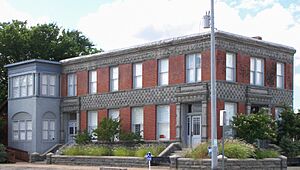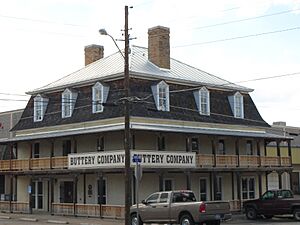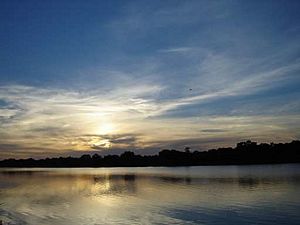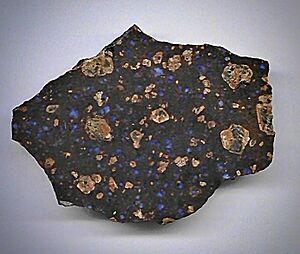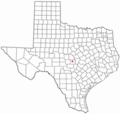Llano, Texas facts for kids
Quick facts for kids
Llano, Texas
|
|
|---|---|
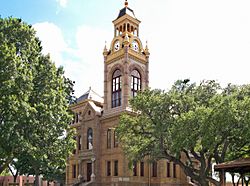
The Llano County Courthouse
|
|
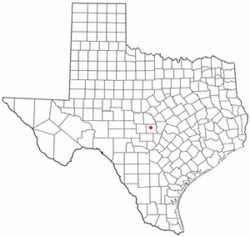
Location of Llano, Texas
|
|
 |
|
| Country | United States |
| State | Texas |
| County | Llano |
| Area | |
| • Total | 5.59 sq mi (14.48 km2) |
| • Land | 5.27 sq mi (13.65 km2) |
| • Water | 0.32 sq mi (0.83 km2) |
| Elevation | 1,024 ft (312 m) |
| Population
(2020)
|
|
| • Total | 3,325 |
| • Density | 594.8/sq mi (229.63/km2) |
| Demonym(s) | Llanite |
| Time zone | UTC-6 (Central (CST)) |
| • Summer (DST) | UTC-5 (CDT) |
| ZIP code |
78643
|
| Area code(s) | 325 |
| FIPS code | 48-43144 |
| GNIS feature ID | 2410852 |
Llano (pronounced LAN-oh) is a city located in Llano County, Texas, in the United States. It is the main city and the county seat of Llano County. In 2020, about 3,325 people lived there. Llano is often called the "deer capital of Texas" because it has the most white-tailed deer in the entire United States!
Contents
History of Llano, Texas
How Llano Was Founded
Llano County was officially created on February 1, 1856. The people chose the spot for the town of Llano on June 14, 1856. They picked a place on the south bank of the Llano River, under a large live oak tree. This spot is near where the Roy Inks Bridge is today.
In the 1870s, Llano was a small frontier town. It had a few log buildings for businesses, a post office, and some homes. It was mainly a trading center for the area.
Growth and Development in Llano
In 1879, the first bank, Moore, Foster, and Company, opened in Llano. During the 1880s, more businesses came to serve the local farmers and ranchers.
The county needed a bigger building for its offices. So, in 1885, a fancy brick courthouse was built in the town square. Sadly, a fire destroyed this courthouse on January 22, 1892. The current county courthouse was finished and opened on August 1, 1893. It is now listed in the National Register of Historic Places.
Newspapers in Llano
The first newspaper in Llano was called the Llano Rural, started in the 1880s. Another paper, the Iron City News, showed how interested people were in the county's minerals. Over time, the Rural combined with other newspapers like the Advocate and the Searchlight. By the early 1900s, it became the Llano News. A famous historian, J. Marvin Hunter, even worked at the Llano Times for a short time.
The Iron Boom and Its End
From 1886 to 1893, Llano experienced a big boom. This was because people found iron deposits at Iron Mountain. Investors from Dallas and other states put money into the town. The Llano Improvement and Furnace Company planned to build an iron furnace and a foundry. They also wanted to develop land on the north side of the river.
There were big plans for a dam, an electric power plant, a streetcar system, and electric street lights. People even called Llano the "Pittsburgh of the West," hoping it would become a major steel town. However, only a small dam and the street lights were completed. At its peak in 1890, the town's population was said to be 7,000.
In 1892, at the height of the boom, Llano became an official city. A bridge was built across the river, and the Austin and Northwestern Railroad reached the north side of town. This improved transportation brought several granite cutting businesses to Llano. Many new brick buildings were constructed around the north side public square. The Algona Hotel became a popular social spot, but it was damaged by a cyclone in 1900 and burned down in 1923.
The boom ended because most of the county's mineral resources, except for granite, were not easy to mine for profit. Also, a series of fires in the early 1890s destroyed many new businesses. These fires were so common that the town could not get fire insurance for several years.
Llano in the 20th Century
Farming, ranching, and the granite industry remained important to Llano's economy. In the 1920s, Llano was a major place for shipping cattle. Cotton farming was popular until the 1930s. Granite quarrying continued to be a big industry, earning a million dollars a year by the 1950s.
The Roy Inks Bridge, named after a former mayor, was built after a flood in 1935 destroyed the old bridge. By 1964, Llano had a new hospital, schools, a community center, and a golf course. It also became a key part of the Highland Lakes tourist area, attracting many hunters during deer season. New industries included a winery and the production of insecticides and talc.
In 1975, famous actress Sophia Loren helped raise money for the Holy Trinity Catholic Church in Llano. By 1983, several buildings in Llano were listed on the National Register of Historic Places. These included the courthouse, the Llano jail, the Southern Hotel, and the Badu Building. The Badu Building was once a bank and home of a mineralogist named N. J. Badu.
Geography of Llano
Llano is located at 30°45′03″N 98°40′48″W / 30.750953°N 98.680038°W. It sits on the Llano River. The city is about 65 miles (105 km) northwest of Austin and 102 miles (164 km) north of San Antonio.
The United States Census Bureau says that Llano covers about 4.7 square miles (12.2 km2). Most of this area, about 4.4 square miles (11.4 km2), is land. The remaining 0.3 square miles (0.8 km2) is covered by water, making up about 5.53% of the total area.
Population of Llano
| Historical population | |||
|---|---|---|---|
| Census | Pop. | %± | |
| 1860 | 77 | — | |
| 1870 | 188 | 144.2% | |
| 1880 | 213 | 13.3% | |
| 1910 | 1,687 | — | |
| 1920 | 1,645 | −2.5% | |
| 1930 | 2,124 | 29.1% | |
| 1940 | 2,658 | 25.1% | |
| 1950 | 2,954 | 11.1% | |
| 1960 | 2,656 | −10.1% | |
| 1970 | 2,608 | −1.8% | |
| 1980 | 3,071 | 17.8% | |
| 1990 | 2,962 | −3.5% | |
| 2000 | 3,325 | 12.3% | |
| 2010 | 3,232 | −2.8% | |
| 2020 | 3,325 | 2.9% | |
| U.S. Decennial Census | |||
Llano's Population in 2020
As of the 2020 United States census, Llano had a population of 3,325 people. There were 1,221 households and 809 families living in the city.
| Race | Number | Percentage |
|---|---|---|
| White (NH) | 2,666 | 80.18% |
| Black or African American (NH) | 5 | 0.15% |
| Native American or Alaska Native (NH) | 7 | 0.21% |
| Asian (NH) | 46 | 1.38% |
| Some other race (NH) | 7 | 0.21% |
| Mixed/multiracial (NH) | 133 | 4.0% |
| Hispanic or Latino | 461 | 13.86% |
| Total | 3,325 |
Historic Places in Llano
Llano has several buildings that are listed on the National Register of Historic Places. These places are important because they help tell the story of the city's past.
Badu Building
The Badu Building was once a bank and the home of a French mineralogist named N. J. Badu. Today, it is a bed-and-breakfast.
Llano County Courthouse and Red Top Jail
The current Llano County Courthouse was built in 1893 after the previous one burned down. It is a beautiful and historic building.
Southern Hotel
The Southern Hotel is another historic building in Llano. It played a role in the town's social life during its boom period.
Education in Llano
The Llano Independent School District serves the city of Llano. This school district includes:
- Packsaddle Elementary
- Llano Elementary
- Llano Junior High
- Llano High School
The school mascot for Llano is the Yellow Jacket, and the school colors are orange and black. The district serves about 1,900 students.
Fun Things to Do in Llano
Llano offers many outdoor activities and interesting places to visit.
Hunting in Llano
Llano is famous as the "Deer Capital of Texas." It has the highest number of deer per square mile in the country. Hunters come from everywhere to hunt deer, quail, dove, feral pigs, and turkey. Both gun hunting and bow hunting are popular here.
Bird Watching in Llano
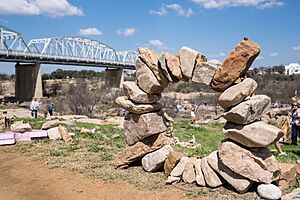
During the winter, bald eagles make their home in Llano County. Many of these majestic birds can be seen around the Lake Buchanan area during their annual migration.
Geology and Archaeology in Llano
Llano County is the only place in the world where you can find a rare rock called Llanite. This rock is a type of brown rhyolite porphyry with unusual sky-blue quartz crystals and rusty-pink feldspar. You can find Llanite along a highway cut about 9 miles (14 km) north of Llano on Texas 16. The largest polished piece of Llanite in the world is displayed at the Badu House.
The area around Llano has been home to various Native American tribes for centuries. This means there are many archaeological sites that attract people interested in history and artifacts.
You can see a large collection of Native American and early Texan artifacts at the Llano County Museum. The museum also has a big display of local gems and minerals.
Media in Llano
Newspaper
- The Llano News
Radio Stations
- KVHL/91.7: Public radio
- KJFK-FM/96.3: Adult hits music
- KITY/102.9: Oldies music
Notable Person from Llano
- W. C. Jameson, an author, musician, and actor, lives in Llano.
Images for kids
See also
 In Spanish: Llano (Texas) para niños
In Spanish: Llano (Texas) para niños


